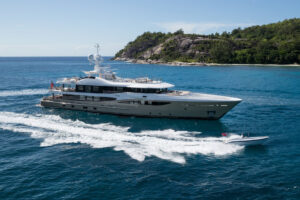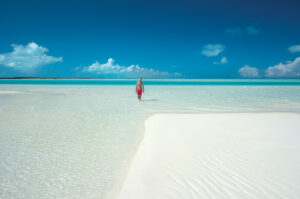In today’s hectic times, comfort is a major concern and leisure time has paramount importance. All the more reason to cruise aboard a traditional trawler. These long-legged motoryachts allow time for enjoying the scenery, all the while providing a spacious home-away-from-home for family and friends.
If you’ve got the urge to go, these well-traveled routes will not disappoint.
Fernandina Beach to Bermuda
After telling a few friends I was taking a week off for an 870-mile cruise from Fernandina Beach, Florida, to Bermuda, typical responses were, “What type of sailboat? “What race?
My eager reply was the 37-foot Mirage Navigator Semper Fi-a salty-looking trawler yacht built in Gainesville, Florida. After several sailboat trips from New England to Bermuda, making headsail changes at 3 a.m. while thrashing around on the foredeck, I was looking forward to the more relaxed pace of cruising on a well-found passagemaker.
Preparation aside, a passage to Bermuda from the East Coast will average four to six days on a well-found trawler. This is a perfect amount of time to slip into the routine and rhythm of an offshore passage, substituting weather reports and good books for cell phones and morning meetings.
Because this trip doesn’t require extensive work in the way of plotting a course, one of its most vital aspects is proper weather forecasting. For this reason, a summer trip is preferable and offers less chance of high winds associated with early winter or late spring storms. It will be crucial that you monitor the tropical storm forecast, since a summer trip means a crossing during hurricane season. Pick a weather window with an ample fudge factor on the end of the trip, and calculate worst-case speed scenarios.
You’ll also need to be able to monitor weather en route. Several weather forecast services can keep you informed, and satellite downloads are an option as long as you plan a backup. Mirage President Ken Fickett provided weather updates via satellite phone at set times during our trip and tracked our progress, providing an added element of safety. With the exception of a few beam seas on our fourth day, the water lay flat, like a vast plane that extended miles and miles.
Of course, a good crew that can troubleshoot, forecast weather and operate self-sufficiently is important, but just as important is having a seaworthy trawler that is properly equipped. Before setting out, know how your boat handles in a variety of sea conditions. How is the boat going to enter an 8-foot head sea? Does she handle large beam swells well, or does her after end get slammed? An uncomfortable motion can be unsafe or, more likely, damn annoying after several days. Consider the amount of exposed glass on your boat and her ability to run with the weather if need be.
Most important, this trip requires a boat with the range to reach Bermuda with reserves should weather force you to extend your time at sea.
We arrived in Bermuda after just five days, well rested with clean laundry, full bellies and not one 3 a.m. sail change.
-George Sass, Jr.
Inside Passage
People who refer to the Inside Passage are generally speaking of the roughly 1,100 nautical miles just above the U.S./Canadian border around Victoria or Vancouver, British Columbia, that continues to Skagway, Alaska. Like Norway’s eastern coast, the shoreline of British Columbia and Alaska is serrated and rough, with literally thousands of fjords that are deep (more than 1,000 feet) and long (more than 100 miles), plus countless islands. Snowcapped canyons, glaciers, and small fishing and lumber villages make for a beautifully diverse trip.
Most of the supplies for the villages are brought in by sea, so cruisers need to be prepared with provisions and gear. Fuel is readily available at fairly short intervals.
A round-trip voyage can be made in one month, but two would be better. Needless to say, this is a summer-only trip. Winter can be appalling. Many owners do the cruise in come-and-go fashion: taking the boat for a few weeks, leaving it to fly home (easy via seaplanes), returning to cruise another segment. Exploring any of the inlets adds mileage. Princess Louisa Inlet, for instance, ups the distance by 100 miles.
There are three basic segments to the trip. Starting at Victoria or Vancouver, the first leg runs roughly 250 miles inside the protection of Vancouver Island to Cape Caution. This is the Straits of Georgia. By and large, it is benign because the bulk of Vancouver protects the passage from the ferocity of North Pacific weather, but it can be downright nasty. There is really no place where you wouldn’t want to watch the weather charts and keep a couple of good protected anchorages in mind. The first leg also has the famed Princess Louisa Inlet with Chatterbox Falls at the innermost end, but you have to go through the entrance to the fjord at slack water. The currents run up to 12 knots as 40 miles of fjord empties or fills through a narrow pass.
The second leg is from the end of Vancouver Island and Cape Caution to Ketchikan. At first, there is an expanse of unprotected water, so watch the weather carefully. Hecate Strait can be fearsome, but most skippers wind through the usually calm passages with good protection from the dozens of islands.
The third leg is Ketchikan to Juneau, again winding through islands and inside Prince of Wales Island, and the scenery includes everything from glaciers to rain forests, dotted with lumber towns.
Juneau is the capital, and most cruisers who make it this far continue north another 100 miles to Skagway, where gold miners once set out for the Yukon territories. Rather than go straight to Skagway, it’s well worth a 200-mile side trip to explore Glacier Bay, where you can chip ice for your cocktails from glaciers millennia old and where the scenery is truly spectacular.
-Chris Caswell
Florida to St. Thomas, USVI
The Virgin Islands have long been a popular choice for cruising sailors looking for a season of trade wind breezes, tropical sunsets, fruity drinks and stunning scenery. Often though, many view the nearly 1,000-nautical mile trip from Florida to St. Thomas as daunting and avoid venturing beyond the Bahamas. True, this trip has obstacles and requires proper planning and a knowledgeable skipper, but it’s worth the effort thanks to good fuel stops, plentiful hurricane holes and the many rewards of the Virgin Islands cruising season.
Your choices in planning this trip depend on your boat, its fuel consumption rate, the speed you wish to cruise and the amount of time you have. Weather is also key: Even when you’re cruising at 20 knots, the blustery trade winds can stir up a head sea that dictates slowing to a more moderate speed. In November and December, the trades are northeast and usually moderate; they increase after January.
The most practiced route and one that offers the bonus of some fine cruising is a passage across the Great Bahama Bank or North West Providence Channel. Assuming your goal is to get to the Virgin Islands quickly, you may wish to bypass the traditional quick hop over to ports of entry such as Bimini and West End. Depending upon your range and the time allotted, options include a layover in Nassau. My preference is to cruise to the Exuma Sound toward the southern end of the chain, making a daylight entry.
South of George Town, fuel management becomes paramount. Between George Town or Rum Cay and the Turks and Caicos chain, there are no simple fuel stopovers. The only options are Clarence Town on Long Island (you have to wait for a truck), Crooked Island (still sketchy for large fill-ups), Mayaguana and Great Inagua. My preference is to head non-stop for about 245 nautical miles from George Town to the Turks and Caicos-if weather allows.
From this point, there are several options; again, your choice depends upon the factors previously mentioned. If you are willing to put up with the often long and, at times, costly clearing-in process, the Dominican Republic offers a few ports for fuel. Today, you need to spend at least a day or two on the island to make the hassle worth your while, but marina development promises to make this a more appealing layover in the next few years.
From there, you’ll begin a coastal cruise along the Dominican Republic coast, past the Mona Passage with a stopover in San Juan and an easy leg to St. Thomas. On average, I’ve completed this passage in about nine days, allowing some time to enjoy the layovers. It is quite possible to make the trip in less time, but doing so is a lot less fun.
If St. Thomas becomes your home base in the Caribbean, you’ll benefit from good flight connections and a yachting infrastructure that can keep your yacht shipshape, even after you head reluctantly back home.
-George Sass, Jr.








